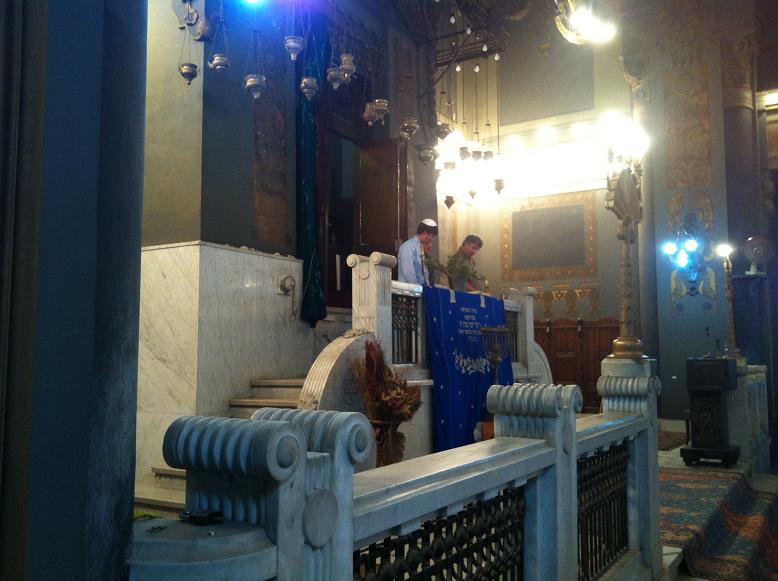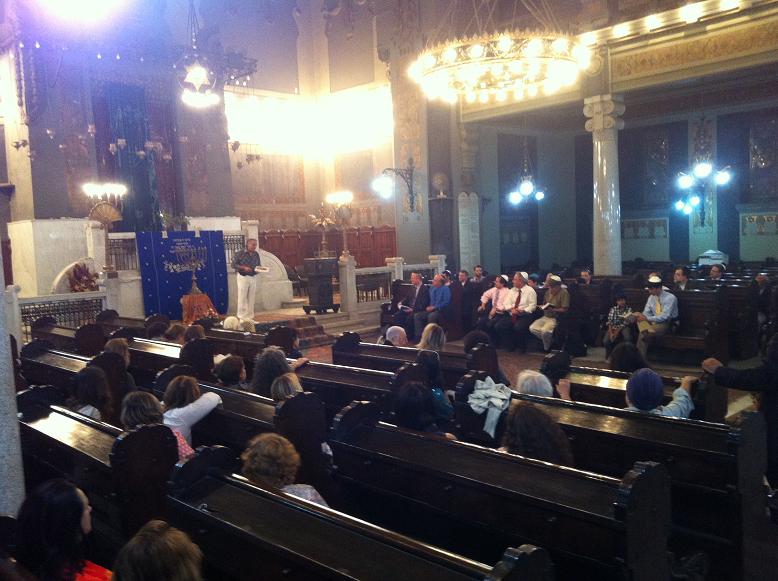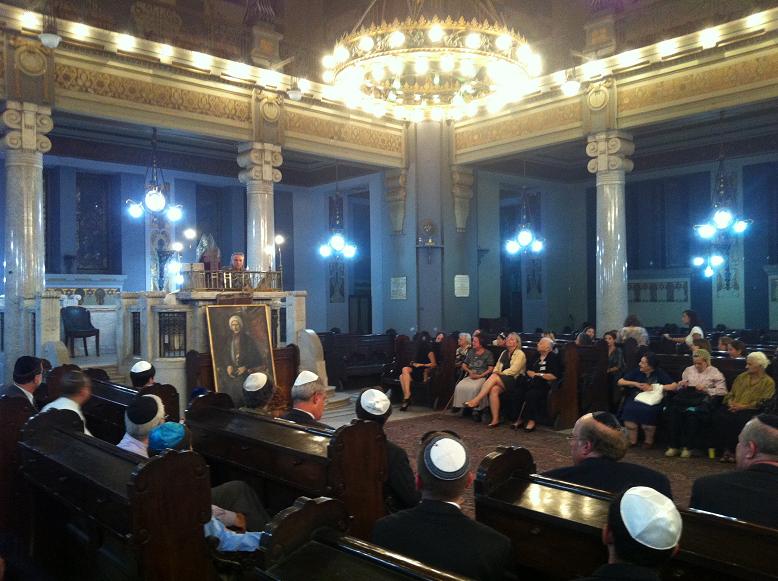
Samir Raafat
By Campbell MacDiarmid
The Torah (the first five holy books of the Jewish faith) encourages Jews to take care of strangers, reminding them that they too were once strangers in the land of Egypt. Since biblical times, Jews have lived in Egypt, making the Egyptian Jewish community one of the oldest in the world. Today, millennia after the arrival of Jews, the community is a fraction of it its former size. While there once tens of thousands living in vibrant communities, today a bare handful remain. They steadfastly hold on to their heritage and tradition, both as Jews and Egyptians.
Every major festival, the community gathers together to celebrate their faith, and as the Torah prescribes, at every festival they welcome strangers; whether they are foreign Jews visiting or living in Egypt, or diplomats and other well-wishers of other faiths. During the recent Jewish festival of Rosh Hashanah, or Jewish new year, I attended a service at the Adly Street synagogue in downtown Cairo.
***
The official name of the Adly Street synagogue is Shaar Hashmayim, meaning Gates of Heaven, founded at the turn of the 20th Century. Built in a neo-Pharaonic style with Jewish touches (or is it in a typical Sephardic Jewish style with neo-Pharaonic flourishes?), it is a unique structure. With the outside adorned with stone palm trees, stars of David, and tall columns, it is both unmistakably Jewish and distinctly Egyptian.
Inside, a soft orange light from tungsten bulbs illuminates the congregation. On the wall, flashes of gilt paint reveal the ornamentation of faded murals. At one end of the square room, shrouded by a velvet curtain, stands the ark, the cabinet in which the Torah scrolls are kept. Opposite the ark is the bima, a raised pulpit from which the rabbi recites prayers and reads from the Torah. The ten commandment tablets and the Star of David chandelier hanging overhead also distinguish the building as a synagogue. A mezzanine floor above once hosted the women of the community, but given the diminished size of the congregation, nowadays the genders are separated by sitting on opposite rows of pews, either side of the ark and bima.
Overall, the impression is of a grand old building with much of the life gone out of it. Unlike the utilitarian mosques on virtually every street in Cairo, which are filled daily with the faithful, services are only conducted at the synagogue during the Jewish festivals.
Around 50 are gathered for the Rosh Hashanah service. A handful of older women sit on the front row of pews furthest from the entrance. They are the Egyptian Jews, members of a community with roots in Egypt as old as any. Behind them sit younger women, largely American students and a few diplomats. On the male side opposite sit men in suits from various embassies and some younger foreigners.
As people arrive they greet each other in a number of languages. “Shana Tova,” “kol sanna wante tayyiba,” “bienvenu,” “nice to meet you.” I meet a diplomat who tells me his grandmother was Jewish, so he can say he is Jewish too, “depending on who is asking.”
I take a seat and wait for the service to start. As I look around me I notice several large marble tablets with the names of wealthy donors who contributed financially to the construction of the synagogue. Looking at the wooden pews, I notice each seat has a metal plaque. Inscribed, barely legible under layers of accumulated varnish, are the names of the old congregation. I am sitting in Jacques Arditi’s space. I try to imagine how Cairo must have been in his time, when well-to-do Jewish businessmen formed an integral part of the booming city’s economic life and were able to construct such an impressive house of worship. Rolling back the years even further, I consider the length of time which the Jews have been in Egypt.
***
Biblically speaking, Jews have lived in the Nile Valley since before Moses was abandoned on its waters. And like the yearly floods on the Nile, throughout history the size of the Jewish population has expanded and contracted.

Samir Raafat
The synagogue in Adly Street may be the largest in Cairo, but is by no means the only, or oldest. Ben Ezra synagogue in old Cairo, is thought to be the oldest synagogue still in use in the world, and legend has it is located on the spot where the pharaoh’s daughter spotted Moses in his basket among the reeds on the river bank.
According to tradition, the Ben Ezra synagogue was given to the Jewish population living in Fostat by Alexander the Great in 300 BCE. When the Jews left for Jerusalem, the Copts took it over as a church. During the reign of Ibn Tulun, the building was sold back to the Jews for 20,000 dinars in 882 CE.
Aside from its mythical connection to Moses, the synagogue is historically significant for the discovery a huge number of Jewish manuscripts, known as the Cairo Geniza, in one of its rooms in the late 19th century. Jewish belief holds that documents written in Hebrew bearing the four letters of the name of God can never be destroyed. When books, letters or manuscripts containing God’s name were no longer of service they were placed in a horde, or Geniza, to be later buried in a cemetery. In what one of the most significant finds of its kind, over 200,000 fragments, some dating from as far back as 870, were found in the Cairo Geniza, documenting in detail Jewish life and culture in Egypt.
The synagogue stands behind the Hanging Church in Coptic Cairo, accessed today via a sunken alley running under the grounds of the monastery and Church of Saint George from near the Mar Girgis Metro stop. The architecture inside is striking for its blend of Jewish, Islamic and even Christian elements.
Unlike the Adly Street synagogue, from the outside Ben Ezra is an unassuming building. But inside the walls are adorned with endless repeating geometric patterns and flowing motifs. The wooden ark, itself decorated and inlaid with mother of pearl and ivory, resembles a Kebla, the prayer nook in Mosques indicating the direction of Mecca. Yet it is flanked by candelabra and overhead sit the Ten Commandments. Rooms either side of the ark and stained glass windows are said to be former confessionals from when Ben Ezra was a church. A mezzanine floor is supported on columns and it is on this floor, closed to the public, where the Geniza was found.
The fusion of Jewish and Islamic styles of Ben Ezra synagogue hints at the integration of the Jews in Egypt throughout history, a fact that is confirmed by the documents found in the Geniza which demonstrate that they were deeply rooted in Egyptian society and involved in daily life. The age of Ben Ezra, the harmonious blend of its architectural styles, and its location in the heart of Coptic Cairo, in the middle of an Islamic society, all points to a long history of religious tolerance in Egypt, a history too often overshadowed by recent events.
Although indigenous Karaite Jews have lived in Egypt since before the birth of Christ, successive waves of Jewish immigrants also came to Egypt. Sephardic Jews arrived after being expelled from Spain or other parts of the Ottoman Empire and Ashkenazi Jews fled Pogroms in Eastern Europe to find a home in Egypt. The bulk of the modern Jewish population in Egypt came in the period which followed the creation of the Suez Canal in 1869, drawn by the blossoming trade enabled by the opening of the new sea route.
By the twentieth century the Jewish community in Egypt was as cosmopolitan as any. A list from the 1950s gives the birthplace of various prominent Cairo Jews and includes: Baghdad, Aden, Damascus, London, Istanbul, Tripoli, Split, Modena and Beirut. By that time there were more than 30 synagogues in Cairo. The most recent is the Meir Biton synagogue, built in 1934 in Maadi, itself a suburb built by Jews. It is estimated that between 50,000-100,000 were living in Egypt at various times during the first half of the 20th century.
However following the creation of the state of Israel in 1948, Jews faced pressure to leave Egypt.
More left after the 1952 revolution and the nationalisation of foreign businesses that followed. The 1956 Suez Crisis when England and France attempted to take back the Suez Canal after President Gamal Abdel Nasser nationalised it, resulted in foreign nationals of those countries becoming personae non grata. The final event encouraging many to leave their homeland, was the 1967 war with Israel.
Those who stayed were mostly childless, resulting in a “diminished community,” as the president of the Jewish Community Council (JCC) Carmen Weinstein puts it. It would be impossible to write of the modern Jewish community in Cairo without talking about Weinstein. For decades she has worked tirelessly to preserve Cairo’s Jewish heritage for future generations. Starting first with a campaign to conserve Bassatine, the second oldest Jewish cemetery in the world, during the construction of the ring road, Weinstein has spearheaded numerous restoration efforts to ensure the preservation of Jewish heritage for future generations.
That those future generations will unlikely be Jewish is clear, as nearly every newsletter of the JCC is punctuated with the obituaries of community members. However, as Weinstein has said in the past, “whether or not there are Jews or pharaohs in present day Egypt is irrelevant. Their legacy is sacred. It is part of the Egyptian national heritage.”
***

Samir Raafat
Weinstein has also worked to ensure that so long as there are Jews in Egypt, ceremonies will continue to be held. While the Jewish community doesn’t have its own rabbi, Rabbi Mark El Fassi comes from France to lead important services.
Dressed in a white suit with a wide open collar and a casual, friendly manner, El Fassi doesn’t look like the stereotype of a Jewish rabbi. He welcomes friends and strangers alike and, when it appears that everyone has arrived, with little ceremony he climbs the bima and begins the ceremony.
He begins by welcoming us in French, and reminds those present of the tolerance the Egyptian government has shown towards the community. With the bodies of the congregation warming the synagogue, the temperature begins to rise and El Fassi dabs ineffectually at his forehead with an increasingly sodden tissue. His voice cracks as he struggles to overcome the acoustics until someone brings him a glass of water.
Due to its status as a historical building there is no air conditioning and El Fassi struggles until three Egyptian men lurking in the background manage to find a fan and an extension cord to set up behind him. The service is a Sephardic one according to an American student sitting near me and he and many of the foreigners seem unfamiliar with the proceedings. However, when El Fassi draws back the curtain to unlock the covenant and open the ancient scrolls I have the sense of a timeless ritual being re-enacted.
And it is an ancient tradition, as we are entering the Jewish calendar year 5773. I ponder this in the context of the sad decline of the Jewish community here in Egypt. But then something else hits me; this is exactly how communities of Jews have observed their ceremonies for millennia. Small congregations throughout history have gathered like this to celebrate their holy days, while living as minorities. Uncertainty of the future has been a constant for Judaism.
Their demise has been predicted repeatedly. They have faced persecution and repression time and again. And this to me demonstrates the resilience of the Jewish faith; its ability to persevere in the face of adversity through observance of their traditions. Weinstein’s continuing to organise the services every year strikes me as a microcosm of the Jewish faith across the ages; the stubborn refusal to let go of one’s faith against all odds.
Afterwards I talk to the young American who sat next to me. He is studying in Cairo and says that living here he doesn’t normally talk about being Jewish. “It’s not that I’m ashamed… it’s that I don’t want people to shut down to me just because of that.” For that reason he asked not to be named. He says, “I think it’s amazing that they are still around and that they have managed to hold onto their faith. It’s remarkable Carmen continuing to organise these services.”
He says he found the service unfamiliar but found parallels with his own community back in the United States. “It doesn’t matter where you go in the world, you find old Jewish women like that… they reminded me of my grandmother.” Since being here, he says he misses his own congregation and likes to watch the services which are streamed online. The chance to attend a service in person was what brought him to the synagogue.
So while there might not always be a Jewish community in Egypt, it seems that for the foreseeable future at least there will be Jews. Through the work of Weinstein, Jewish patrimony is likely to remain too.
For example, today Ben Ezra synagogue is open to the public. When I visit numerous groups pass through. Muslim schoolgirls sit on one of the benches. A group of French, Italian and Spanish tourists enter, arguing about whether there are still Jews in Egypt. Next a large group of middle aged Indians, the women dressed in bright saris, the men wearing caps and lanyards that read “Holy Land Tours” are shepherded in by a man wearing a microphone headset. Finally I sit with two local boys who tell me they have come, “just to see.”
In one of the JCC newsletters, Weinstein quotes Jacques Hassoun, who wrote a history of Judaism in Egypt, “Jews have always been an integral part of Egypt. This is where it all began. They are inseparable from one another. And if we are nowadays going through a period of contraction, it is simply part of a recurrent cycle.”


